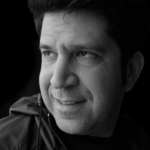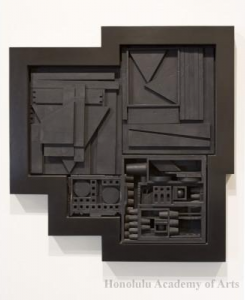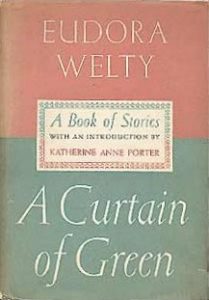Spring 2018
2
Box and Cylinder, Crystal and Flame:
Some Thoughts on Form and Tension
Scott Nadelson, RWW Faculty
Box and Cylinder, Crystal and Flame:
Some Thoughts on Form and Tension

Scott Nadelson
RWW Faculty
It happens every time I visit a museum with a significant modern art collection. Most recently it was in Honolulu, where, after ducking out of an excruciating academic conference, I stepped inside to wait out a rainstorm before taking a hike. (The storm didn’t pass, but I didn’t return to the conference; I got soaked to the skin on my way up and down Diamond Head.) I wandered around for half an hour, admiring the Japanese woodblock prints and paintings by contemporary Hawai’ian artists, and then I found myself drifting toward the museum’s single Louise Nevelson piece, an assemblage called Black Zag X. And as always when confronted with Nevelson’s work, I stopped in my tracks and stood in front of it for another half hour while rain drummed on the roof.
I’ve spent a good bit of time over the past year trying to understand why I’m so enamored of Nevelson’s sculpture. I’ve taken out every book about her in my university’s library and have ordered many more through interlibrary loan. I stare at images of her work before sitting down to write every morning. I read interviews and watch videos of her putting pieces together in her studio a few years before she died. There’s certainly much in her biography that appeals to me—a Russian Jew who emigrated around the same time as my grandparents, a sexually liberated woman long before it was fashionable, an obsessive and driven creator who learned to trust her instincts despite many years of neglect by the art world—but her life story probably wouldn’t mean a lot to me if I didn’t first love her work.
 Black Zag X has all the features of her best-known sculpture, though on a smaller scale than her most famous pieces: a collection of wooden boxes, filled with arrangements of found wooden objects, all painted black. In two larger boxes on top are wooden rectangles and triangles; in the smaller two on the bottom are cylinders and disks and cones with the ends snipped off. Around the boxes a black frame zigs and zags to follow their outline.
Black Zag X has all the features of her best-known sculpture, though on a smaller scale than her most famous pieces: a collection of wooden boxes, filled with arrangements of found wooden objects, all painted black. In two larger boxes on top are wooden rectangles and triangles; in the smaller two on the bottom are cylinders and disks and cones with the ends snipped off. Around the boxes a black frame zigs and zags to follow their outline.
So what is it about these wooden boxes stuffed with bits of painted wood that gets under my skin? The variation in pattern, certainly, the tension between straight lines and curves, between regularity and surprise, between the confinement of the container and the near-chaos of what fills it. Tension, too, between the sculpture’s intense physicality—so tactile you can feel the textures against your fingers even though a museum guard is carefully watching to make sure you don’t actually touch it—and its relentless abstraction. In one of the many interviews I’ve read, Nevelson vigorously denies any hint of representation in her work; when the interviewer suggests her pieces “take on certain organic meanings when you start putting them together [and] acquire potency as images—say, of parts of the body or of flowers,” she replies, with a touch of exasperation, “No, they’re not to do with the human body or flowers; they’re to do with themselves, as they are. I see if they are valid and right and I don’t have to superimpose another thing.”
In the same interview, however, when asked whether it makes sense to talk about the poetic qualities of her work and whether comparisons to Emily Dickinson and Marianne Moore are valid, she quickly responds in the affirmative. “I am aware of the formal need for what really constitutes the work,” she says, but adds, “I also feel that the very nature of one’s nature has something to do with it, so if your nature is, let us assume, poetic, naturally it’s going to be projected onto it.” Poetry, too, depends on the tension between regularity and variation, between the concrete and the ineffable. Staring at Black Zag X, I experience many of the same contradictions as when I read lines like these: “The Feet, mechanical, go round— / A Wooden way / Of Ground, or Air, or Ought.” In Dickinson, sound and rhythm ground me in the senses, while elusiveness and abstraction transport me into the mysteries of consciousness and mortality.
In creative writing workshops, especially those focused on narrative, we spend most of our time discussing the concrete and sensory. More detail, we say; make clearer external drama. It’s harder to talk about the function of abstraction and mystery, especially as we’re already wrestling with the abstracting nature of language. Unlike Louise Nevelson, we don’t have wood to keep us anchored to the physical world, and as a result we sometimes lose sight of the possibilities offered by those aspects of language that counterbalance the physical, that can give our work its poetic quality. So with Nevelson in mind, I’ll turn to her near-contemporary, Eudora Welty (what a pairing for an imaginary dinner party!), a writer who creates tension between the concrete and the abstract as well as any other I know.
 Take a story like “The Hitch-Hikers,” from her first collection, A Curtain of Green. The dramatic surface of the story is straightforward and clear, the details vivid, the dialogue sharp and often comic. On the road to Memphis, a traveling salesman picks up a pair of hitchhikers and takes them to Clearwater, a town he has visited many times before. When his back is turned, one of them tries to steal his car, and the other bludgeons the first with a bottle. Then, while waiting to find out if the first hitchhiker will recover, the salesman checks into the hotel, sees some old friends, and attends a party with a pair of women clearly smitten with him. In the night, one of those women comes through a rainstorm to see him; he sends her away and then learns that the hitchhiker has died. In the morning, he appears at the courthouse to testify, but as it turns out, his testimony isn’t necessary. The murderer confesses, boastfully, and the salesman heads on to the next town.
Take a story like “The Hitch-Hikers,” from her first collection, A Curtain of Green. The dramatic surface of the story is straightforward and clear, the details vivid, the dialogue sharp and often comic. On the road to Memphis, a traveling salesman picks up a pair of hitchhikers and takes them to Clearwater, a town he has visited many times before. When his back is turned, one of them tries to steal his car, and the other bludgeons the first with a bottle. Then, while waiting to find out if the first hitchhiker will recover, the salesman checks into the hotel, sees some old friends, and attends a party with a pair of women clearly smitten with him. In the night, one of those women comes through a rainstorm to see him; he sends her away and then learns that the hitchhiker has died. In the morning, he appears at the courthouse to testify, but as it turns out, his testimony isn’t necessary. The murderer confesses, boastfully, and the salesman heads on to the next town.
Right from the start of the story, however, Welty occasionally allows her language to shift into abstraction, taking us beneath the story’s clean surface to reveal a mysterious undertone. When the salesman, Tom Harris, first spots the two hitchhikers, he is overtaken by “the flash of a sensation he had learned to experience when he was a child: standing still with nothing around him, standing tall, and having the world come all at once into its round shape underfoot and rush and turn through space and make his stand very precarious, and lonely.” Out of the particulars of hitchhikers appearing in the landscape comes an evocative but intangible feeling of smallness and solitude in the great big universe, a feeling that both triggers the drama that follows and gives it meaning. We see that Harris just wants to ease the loneliness brought on by this sensation, so he picks up the two men, even though he has already realized they aren’t casual hitchhikers but “full-blown tramps.”
By the end of the story’s first page, we might begin to intuit that this is less a story about hitchhikers than one about Harris’s loneliness. So when we later see Harris with opportunities to connect with others and relieve that loneliness, we likely wonder why he pushes away those who try to get close to him. Isn’t kinship and intimacy what he wanted? While waiting for news of the injured hitchhiker’s condition, he lies on his hotel bed under a fan that does nothing to alleviate the heat, thinking about the girls at the party and their futile attempts to draw him into their lives. And once more, Welty takes us deeper by allowing the language to swerve into abstraction: “He knew he would not be held by any of it. It was for relief, almost, that his thoughts turned to pity, to wonder about the two tramps, their conflict, the sudden brutality when his back was turned—how would it turn out? It was in this suspense that it was more acceptable to him to feel the helplessness of his life.”
What a strange progression of emotion. Harris recognizes himself as the object of others’ desires, but rather than act on that knowledge, he distracts himself with pity, which brings relief. And only then can he allow himself to feel the emotion that undergirds all others, his own sense of helplessness born of a life of drifting: “none of any of this his, not to keep, but belonging to the people of these towns he passed through, coming out of their rooted pasts, out of their remaining in one place, coming out of their time. He himself had no time. He was free; helpless.” Once again, Welty’s abstraction points us toward the story’s true subject, its central mysteries. There is a man dying from violence in a nearby hospital, but the real ghost is the one who passes through these towns without connection, whose freedom from time and place has left him helpless, unable to feel anything but all alone on a rock spinning through space.
In his essay “Exactitude,” from Six Memos for the Next Millennium, Italo Calvino (another guest for our dinner party) offers a pair of metaphors for two opposing formal impulses of literature: “crystal” and “flame.” The former is perfectly constructed and logically organized, precise and intricate, captivating but contained; the latter is fueled by heat and energy, wild and unpredictable, mesmerizing but impossible to hold. “I have always considered myself a partisan of the crystal,” Calvino says, but he urges himself “not to forget the value of the flame as a way of being, a mode of existence.” Instead of relying solely on one form in place of another, he argues, it’s the contrast of competing forms—in Nevelson, tactile wooden shapes to create abstract imagery; in Welty, precise details, clear drama, and witty dialogue interspersed with language that’s evocative and elusive—that gives a work of art its true power. A crystal on its own is beautiful but static; put a flame next to it, and it’ll come alive with dancing light.
Scott Nadelson is the author of The Fourth Corner of the World, The Next Scott Nadelson: A Life in Progress, and Between You and Me. His stories and essays have appeared in Harvard Review, AGNI, Ploughshares, Glimmer Train, The Southern Review, Crazyhorse, New England Review, Prairie Schooner, and Alaska Quarterly Review and have been cited as notable in both Best American Short Stories and Best American Essays. Winner of the Oregon Book Award, the Great Lakes Colleges New Writers Award, and the Reform Judaism Fiction Prize, he teaches at Willamette University and lives in Salem, Oregon.
